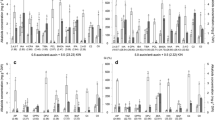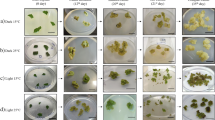Abstract
Callus cultures of Arnebia euchroma (Royle) Johnst can produce considerable amounts of shikonin derivatives, which are shown to possess a wide spectrum of pharmaceutical properties, such as antimicrobial, anticancer, antioxidative, immune regulative and anti-inflammatory. To explore the possible regulation mechanism of shikonin derivatives biosynthesis, the effects of ammonium ion (NH+4) on cell growth and formation of shikonin derivatives in callus cultures of A. euchroma were investigated in this paper. The main results include: When A. euchroma callus were cultured in medium with different concentrations of NH+4 (0 mM, 7.02 mM, 14.04 mM), the fresh weight of the cell cultured in 7.02 mM NH+4 was higher than those in 0 mM and 14.04 mM NH+4, indicating that NH+4 is necessary for the cell growth of A. euchroma callus cultures, while excessive NH4+ concentration (14.04 mM) could rather inhibit the cell growth of A. euchroma. The quantitative analysis of the seven main naphthoquinone compounds showed that the contents of most of the shikonin derivatives (including the bioactive components acetylshikonin and β,β-dimethyl-acrylshikonin) of the Red Strain cultured in 0 mM NH4+ condition were higher than those in other NH+4 conditions (7.02 mM, 14.04 mM) at most of the sample points, suggesting that NH+4 essentially plays an unfavorable role in the biosynthesis of shikonin derivatives. The analysis of quantitative real-time RTPCR showed that a higher NH+4 concentration inhibited the expression of key enzyme genes (such as AePGT) of shikonin derivatives biosynthesis, while -NH4+ condition was conducive to the expression of such genes. In sum, our results show that NH4+ is necessary for the cell growth of A. euchroma, while unnecessary, or even adversary to the biosynthesis of shikonin derivatives.
Similar content being viewed by others
Abbreviations
- AeC4H :
-
Arnebia euchroma cinnamic acid 4-hydroxylase gene
- Ae4CL :
-
Arnebia euchroma 4-coumarate: CoA ligase gene
- GPP:
-
geranyl diphosphate
- AeGPPS :
-
Arnebia euchroma geranyl pyrophosphate synthase gene
- 4-HB:
-
4-hydroxybenzoate
- AeHMGR :
-
Arnebia euchroma 3-hydroxy-3-methylglutarylcoenzyme A reductase gene
- AePGT :
-
Arnebia euchroma p-hydroxybenzoate 3-geranyltransferase gene
- FW:
-
fresh weight
- HPLC:
-
high-performance liquid chromatography
- KT:
-
6-furfurylaminopurine
- IAA:
-
indoleacetic acid
References
Andújar I., Ríos J.L., Giner R.M. & Recio M.C. 2013. Pharmacological properties of shikonin - a review of literature since 2002. Planta Med. 79: 1685–1697.
Chen X., Yang L., Oppenheim J.J. & Howard M.Z. 2002. Cellular pharmacology studies of shikonin derivatives. Phytother. Res. 16: 199–209.
Fujita Y., Hara Y., Ogino T. & Suga C. 1981. Production of shikonin derivatives by cell suspension cultures of Lithosperm,um, rythrorhizon. I. Effects of nitrogen sources on the production of shikonin derivatives. Plant Cell Rep. 1:59-60.
Ge R, Wang X.D. & Wang Y.C. 2003. Advances in studies on medicinal Radix Arnebiae Seu Lithospermi. Chin. Tradit. Herb. Drugs 34: 7–10.
Hao H., Lei C.Y., Dong Q.L., Shen Y.L., Chi J.T., Ye H.C. & Wang H. 2014. Effects of exogenous methyl jasmonate on the biosynthesis of shikonin derivatives in callus tissues of Arnebia euchroma. Appl. Biochem. Biotechnol. 173: 2198–2210.
Heide L. & Berger U. 1989. Partial puri fication and properties of geranyl pyrophosphate synthase from Lithospermum erythrorhizon cell cultures. Arch. Biochem. Biophys. 273: 331–338.
Kim J.Y., Jeong H.J., Park J.Y., Kim Y.M., Park S.J., Cho J.K., Park K.H., Ryu Y.B. & Lee W.S. 2012. Selective and slow-binding inhibition of shikonin derivatives isolated from Lithospermum erythrorhizon on glycosyl hydrolase 33 and 34 sialidases. Bioorg. Med. Chem. 20: 1740–1748.
Lange B.M., Severin K., Bechthold A. & Heide L. 1998. Regulatory role of microsomal 3-hydroxy-3-methylglutaryl- coenzyme A reductase for shikonin biosynthesis in Lithospermum erythrorhizon cell suspension cultures. Planta 204: 234–241.
Li G.R., Wu Z.R., Ye H.C., Lu R.S. & Xiang G.Q. 1988. Induction and formation of the naphthoqunone pigments in vitro in Arnebia euchroma. Chin. Bull. Bot. 5: 84–86.
Linsmaier E.M. & Skoog F. 1965. Organic growth factor requirements of tobacco tissue cultures. Physiol. Plant. 18: 100–127.
Matsuno M., Nagatsu A., Ogihara Y., Ellis B.E. & Mizukami H. 2002. CYP98A6 from Lithospermum erythrorhizon encodes 4-coumaroyl-4’-hydroxyphenyllactic acid 3-hydroxylase involved in rosmarinic acid biosynthesis. FEBS Lett. 514: 219–224.
Rohr F., Ulrichs C., Schreiner M., Zrenner R. & Mewis I. 2012. Responses of Arabidopsis thaliana plant lines differing in hydroxylation of aliphatic glucosinolate side chains to feeding of a generalist and specialist Caterpillar. Plant Physiol. Biochem. 55: 52–59.
Tabata M., Mizukami H., Hiraoka N. & Konoshim M. 1974. Pigment formation in callus cultures of Lithospermum erythrorhizon. Phytochemistry 13: 927–932
Tabata M. 1996. The mechanism of shikonin biosynthesis in Lithospermum cell cultures. Plant Tiss. Cult. Lett., 13: 117–126.
White P.R. 1954. The cultivation of animal and plant cells. The Ronald Press Co., New York.
Wu Y.Y., Zhu L., Ma X.Y., Shao Z.J., Chen J., Chen X.J., Wan L.H. & Zhou L.M. 2011. The antiproliferation effect of Aikete injection on hepatocellular carcinoma in vitro and in vivo. Pharm. Biol. 49: 531–538.
Yamamura Y., Ogihara Y. & Mizukami H. 2001. Cinnamic acid 4-hydroxylase from Lithospermum erythrorhizon: cDNA cloning and gene expression. Plant Cell Rep. 20: 655–662.
Yamamura Y., Sahin F.P., Nagatsu A. & Mizukami H. 2003. Molecular cloning and characterization of a cDNA encoding a novel apoplastic protein preferentially expressed in a shikonin-producing callus strain of Lithospermum erythrorhizon. Plant Cell Physiol. 44: 437–446.
Yazaki K., Fukui H., Kikuma M. & Tabata M. 1987. Regulation of shikonin production by glutamine in Lithospermum erythrorhizon cell cultures. Plant Cell Rep. 6: 131–134.
Yazaki K., Ogawa A. & Tabata M. 1995. Isolation and characterization of two cDNAs encoding 4-coumarate:CoA ligase in Lithospermum cell cultures. Plant Cell Physiol. 36: 1319–1329.
Yazaki K., Kataoka M., Honda G., Severin K. & Heide L. 1997. cDNA cloning and gene expression of phenylalanine ammonia-lyase in Lithospermum erythrorhizon. Biosci. Biotechnol. Biochem. 61: 1995–2003.
Yazaki K., Matsuoka H., Ujihara T. & Sáto F. 1999. Shikonin biosynthesis in Lithospermum erythrorhizon: light-induced negative regulation of secondary metabolism. Plant Biotechnol. 16: 335–342.
Yazaki K., Matsuoka H., Shimomura K., Bechthold A. & Sato F. 2001. A novel dark-inducible protein, LeDI-2, and its involvement in root-speci fic secondary metabolism in Lithospermum erythrorhizon. Plant Physiol. 125: 1831–1841.
Yazaki K., Kunihisa M., Fujisaki T. & Sato F. 2002. Geranyl diphosphate: 4-hydroxybenzoate geranyltransferase from Lithospermum erythrorhizon. Cloning and characterization of a ket enzyme in shikonin biosynthesis. J. Biol. Chem. 277: 6240–6246.
Zhang W.J., Zou A.L., Miao J., Yin Y.L., Tian R.N., Pang Y.J., Yang R.W., Qi J.L. & Yang Y.H. 2011. LeERF-1, a novel AP2/ERF family gene within the B3 subcluster, is down- regulated by light signals in Lithospermum erythrorhizon. Plant Biology (Stuttg) 13: 343–348.
Acknowledgements
The authors would like to thank Mr. Pengyue Li (Institute of Chinese Materia Medica, China Academy of Chinese Medical Sciences) for his help in HPLC and LC-MS analyses. This work was supported by the National Natural Science Foundation of China (grant No. 61173098, No. 61379081).
Author information
Authors and Affiliations
Corresponding author
Rights and permissions
About this article
Cite this article
Hao, H., Pu, G.B., Lei, C.Y. et al. Effects of ammonium ion on cell growth and biosynthesis of shikonin derivatives in callus tissues of Arnebia euchroma. Biologia 70, 1053–1062 (2015). https://doi.org/10.1515/biolog-2015-0122
Received:
Accepted:
Published:
Issue Date:
DOI: https://doi.org/10.1515/biolog-2015-0122




